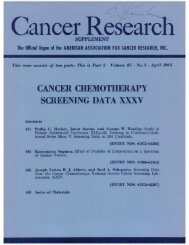XANTHOMA OF THE BREAST In a series of nine hundred (circa ...
XANTHOMA OF THE BREAST In a series of nine hundred (circa ...
XANTHOMA OF THE BREAST In a series of nine hundred (circa ...
Create successful ePaper yourself
Turn your PDF publications into a flip-book with our unique Google optimized e-Paper software.
Downloaded from cancerres.aacrjournals.org on December 28, 2013. © 1932<br />
American Association for Cancer Research.<br />
1084 CUSHMAN D. HAAGENSEN<br />
every instance. He therefore concluded that in secondary<br />
xanthomatous degeneration in true neoplasms, just as with primary<br />
xanthomas, there is an underlying hypercholesterinemia,<br />
Fleissig, and more recently Seyler, have preferred to classify<br />
these giant-cell tumors <strong>of</strong> tendon sheaths as granulomas.<br />
(2) Secondary Xanthomatous Degeneration in Chronic <strong>In</strong>flammatory<br />
Processes: <strong>In</strong> a great variety <strong>of</strong> chronic inflammatory processes<br />
the same type <strong>of</strong> xanthomatous degeneration occurs as has<br />
just been described in neoplasms. The foam cells appear scattered<br />
among the lymphocytes, plasma cells, and polynuclears which<br />
characterize the lesion. Such xanthomatous degeneration is<br />
particularly common in chronic salpingitis, and in the walls <strong>of</strong> old<br />
abscesses. It has been reported in abdominal scars, at the site<br />
<strong>of</strong> arsenic injections, in pock-marks, in the scars <strong>of</strong> herpes zoster,<br />
and at the sites <strong>of</strong> previous chronic skin affections <strong>of</strong> various types.<br />
There are no available reports <strong>of</strong> blood cholesterin determinations<br />
in lesions <strong>of</strong> this type.<br />
<strong>XANTHOMA</strong> <strong>OF</strong> <strong>THE</strong> BREABT<br />
Tumors <strong>of</strong> the breast containing xanthoma cells may be discussed<br />
on the basis <strong>of</strong> the classification outlined above for xanthomas<br />
in general.<br />
A. Primary Xanthoma <strong>of</strong> the Breast<br />
The localization <strong>of</strong> solitary xanthoma in the breast as part <strong>of</strong><br />
the syndrome <strong>of</strong> xanthomatosis must be exceedingly rare. A<br />
search <strong>of</strong> the medical literature reveals only one case report <strong>of</strong> the<br />
condition. Cheatle described a circumscribed but not encapsulated<br />
xanthoma which he removed from the breast <strong>of</strong> a woman<br />
aged thirty-eight. Blood cholesterin determinations were not<br />
done.<br />
The following three cases are examples <strong>of</strong> this type <strong>of</strong> tumor<br />
observed at the Memorial Hospital in a <strong>series</strong> <strong>of</strong> 900 (<strong>circa</strong>) tumors<br />
<strong>of</strong> the breast in which the preoperative diagnosis was carcinoma.<br />
<strong>In</strong> one <strong>of</strong> these cases the breast was removed, and only when the<br />
histologic sections were studied did the diagnosis <strong>of</strong> xanthoma<br />
become apparent. <strong>In</strong> the two other cases a local excision <strong>of</strong> the<br />
tumor was done and a diagnosis <strong>of</strong> xanthoma made from the<br />
yellow color <strong>of</strong> the gross specimen.<br />
CASE 1: C. B. T., an unmarried Irish woman, aged seventy-four, was<br />
referred to Dr. James Duffy at the Memorial Hospital for treatment on<br />
Aug. 17, 1930.
















